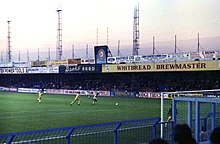
Beginning in at least the 1960s, the United Kingdom gained a reputation worldwide for football hooliganism; the phenomenon was often dubbed the British or English Disease.[1][2][3][4][5][6] However, since the 1980s and well into the 1990s the UK government has led a widescale crackdown on football related violence. While football hooliganism has been a growing concern in some continental European countries in recent years, British football fans now tend to have a better reputation abroad. Although reports of British football hooliganism still surface, the instances now tend to occur at pre-arranged locations rather than at the matches themselves.[citation needed]
- ^ Asser, Martin (19 June 2000). "Analysis: Soccer violence an international problem". BBC News. Retrieved 3 November 2020.
- ^ "A Day Of Horror And Shame". Sports Illustrated. 10 June 1985. Retrieved 3 December 2020.
- ^ "FIG FACT-SHEET FOUR: HOOLIGANISM". Football Industry Group, University of Liverpool. Archived from the original on September 13, 2008. Retrieved March 20, 2011.
- ^ Stott, Clifford; Pearson, Geoff (2007). Football Hooliganism: Policing the War on the English Disease. Pennant Books. ISBN 978-1-906015-05-3.
- ^ Cacciottolo, Mario (April 6, 2007). "The return of the English disease?". BBC News. Retrieved March 20, 2011.
- ^ "Another sorry outbreak of the English disease". The Independent on Sunday. London. June 17, 2004. Archived from the original on April 11, 2008. Retrieved March 20, 2011.
